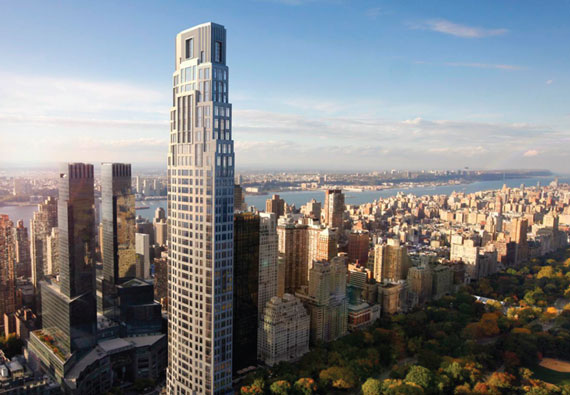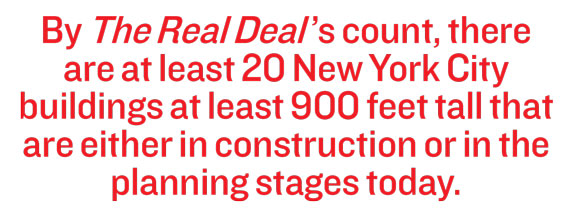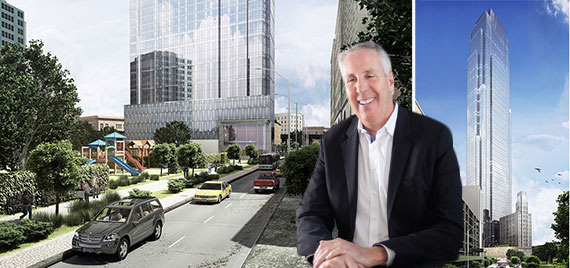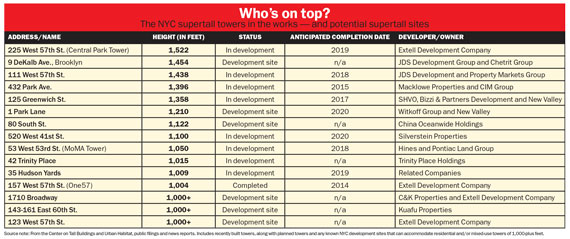Trending
A race to the top
NYC’s sky-soaring residential</br> towers are one-upping each other </br>at an unprecedented pace, </br>but can it continue?

By today’s standards, Harry Macklowe’s Metropolitan Tower on West 57th Street seems quaint.
The early 1980s-era building stands 716 feet tall; its resale condos trade at prices around $1,500 to $2,000 per square foot. But when the spire topped out there in 1982, it set a record as the tallest residential tower in the city.
Today, Macklowe still owns a piece of the city’s tallest apartment building, but it’s at 432 Park Avenue, and it stands almost twice as tall. In addition, the most expensive penthouse there is under contract for $95 million — or roughly $11,500 per square foot.
In a game of construction one-upmanship, developers are surpassing each other at an unprecedented clip to build the next great “supertall” residential building — a term the Chicago-based Council on Tall Buildings and Urban Habitat reserves for towers of at least 984 feet.
An example of this race to the top: At 1,396 feet high, 432 Park overtook Extell Development’s 1,004-foot-tall One57 earlier this year. But Extell is now on track to reclaim the title. Extell’s latest “supertall” building, dubbed Central Park Tower, is scheduled to top out at 1,550 feet in 2019. What’s more, the tower will reportedly have a record $4.4 billion sellout.
The current real estate cycle is on pace to produce as many record-tall residential buildings as the previous eight decades.
But with a historic number of über-luxury condos on the market, and sources of foreign capital in China and elsewhere showing volatility, industry observers are increasingly tossing the word “frothy” around these days in discussions about the New York luxury market.
That raises the question: Will this trend of building supertall luxury apartment towers start slowing anytime soon? Developer Ian Bruce Eichner — whose CitySpire tower became the city’s tallest apartment building when it surpassed Macklowe’s Metro tower in the late 1980s — says yes.
“I don’t think you’ll see another 1,000-foot building in the immediate future,” Eichner said. “Right now it would be very challenging because lenders are very concerned about the absorption at the high end.”
While Eichner may be right about future construction, by The Real Deal’s count, there are at least 20 New York City projects at least 900 feet tall that are either under construction or in the planning stages today. Of that batch, 14 are 1,000 feet or taller.
“Never before have we seen anything like this,” said new development marketing specialist Nancy Packes. “It’s a whole new genre of height and luxury.”
Tall, rich and thin
New York City’s latest supertall spires are not only tall, they are also far more slender than their predecessors.
The ever-shrinking amount of development space in Manhattan has prompted developers to piece together postage-stamp-sized sites and then pack on air rights that allow them to build higher.
From an engineering standpoint, a building is considered “slender” if it has a width-to-height ratio of 1 to 10, meaning it rises 10 feet for every foot of width at its base. Today’s supertall towers, however, are testing the limits of width-to-height ratios.
Macklowe’s 432 Park, for example, has a 1 to 15 ratio. JDS Development and Property Market Group’s 111 West 57th Street is pushing the envelope even further, with a ratio of 1:23, which will make it the world’s skinniest tower when it opens in 2018 at 1,418 feet. (Highcliff Apartments in Hong Kong is currently the planet’s skinniest residential tower with a ratio of 1:20.)
By comparison, the World Trade Center’s original North Tower, which soared 1,368 feet high, had a ratio of less than 1:7 because it had a big broad base, as the Skyscraper Museum has noted.

A rendering of 220 Central Park South
Today’s slender towers are not just altering the look of the skyline, they are also relying on more sophisticated engineering along with high-tech features like sound attenuation, high-speed elevators and wind turbines.
“Slender towers require special measures to counteract the exaggerated forces of wind on the vertical cantilever,” according to a New York Skyscraper Museum exhibit. “This can include additional structures to stiffen the building or various types of dampers to counteract sway.”
That sway does not seem to be impacting the buyers, who are plunking down eight- or sometimes even nine-figure prices for these units. They seem to be more concerned about views and exotic bathtub marbles.
“The people who are buying in these buildings are generally living in or have bought in tall buildings before,” said Sotheby International’s Nikki Field.
Field added that buyers’ attorneys review condo-offering plans with information on sway-preventing dampers. Plus, she said, “The view far outweighs any concern about height.”
Puzzle pieces
Assembling the puzzle pieces for these sky-high residential buildings is another equally complicated challenge and often requires collecting multiple sites (sometimes dozens) along with air rights. Not only does that process require adroit negotiating skills, but it also takes serious patience.
Barnett, for example, spent 15 years assembling the site for One57, originally starting with a plan for a 300,000-square-foot building. But as the market rose, so did his aspirations. The final product was nearly three times what he had originally planned.
“There may be great rewards to New York real estate but you have to have the vision and the patience and the legs to put it together and figure it out,” said Michael Sillerman, co-chair of the land use department at the law firm Kramer Levin Naftalis & Frankel, who along with colleague Paul Selver has worked on many of the 57th Street-area sites. “It’s a very sophisticated game to figure out how to get all the pieces.”
He added: “It’s no accident. You look at the cast of characters who end up doing these. These very tall buildings only resulted from the resourcefulness and expertise of sophisticated builders who put these assemblages together.”
Barnett, who is widely considered an assemblage master, began negotiating to buy the site for his next supertall, Central Park Tower at 217 West 57th Street, around 2003. The complicated land-grab included nearly a dozen different transactions (see related story on page 60).
 Meanwhile, Vornado Realty Trust spent a decade assembling the site where it is building the 950-foot-tall 220 Central Park South. It purchased the first puzzle piece, a 20-story rental building that it later demolished, in 2005. And, after a fierce battle, it also bought Extell out of land and air rights to the tune of $194 million.
Meanwhile, Vornado Realty Trust spent a decade assembling the site where it is building the 950-foot-tall 220 Central Park South. It purchased the first puzzle piece, a 20-story rental building that it later demolished, in 2005. And, after a fierce battle, it also bought Extell out of land and air rights to the tune of $194 million.
A few blocks east and one block north, the Zeckendorfs also pulled a complicated assemblage out of their hat to develop the 33-unit 520 Park Avenue, which will top out at a mere 781 feet.
As TRD has reported, the brothers pieced together six parcels to create the 178,000-square-foot site. They made their first move back in 2005, buying air rights from the Grolier Club and Christ Church, and completed the assemblage in 2013.
For his part, Macklowe first got his hands on the Drake Hotel, future site of 432 Park, in 2006.
Assembling all of the pieces needed for a top-notch site is a complicated and strategic process. Instead of putting adjacent puzzle pieces together, a savvy assembler will often grab a piece from the far end of the board. Sometimes a developer will snap up rights simply to prevent a rival developer from making a play. The process can also be shrouded in secrecy as some purchase these sites through LLCs to hide their identities.
“You try to get what you can and tie it up,” said air-rights expert Bob Shapiro, who has worked on a number of high-profile assemblages such as 432 Park. “Someone like Macklowe doesn’t think linearly. To Harry, it’s a chess game, a three-dimensional chess game.”
Recently, some top developers have also looked to the baron businessmen of a different age for inspiration, creating “vertical tax lots” — which railroad magnates used in the late 19th Century when they assembled the subterranean real estate for projects such as Grand Central Terminal and what is now the Metro-North line.
These vertical tax lots simply exist on paper, acting as a sort of virtual lockbox or cloud for stowing air rights.
Kramer Levin’s Sillerman said using these vertical tax lots is a “relatively new innovation” when it comes to assembling development rights for tall towers.
Barnett used one to store the rights he was collecting for Central Park Tower. That was particularly crucial because a number of the sites he purchased air rights from were separated from his development site by the landmarked home of the Art Students League. Yet Barnett “stationed” his vertical tax lot over the art institute’s property, allowing him to complete his assemblage.
Shorter shoulders
Developers, of course, are not just building tall for the sake of it. They are doing so to create buildings with sweeping city views, which bring them higher prices for their apartments.
And, the higher that buildings in one particular area rise, the taller the next developer must build in order to best those views.
While One57 — which sold a record-high $100.4 million penthouse — was the first building to cross the supertall threshold, it was actually Forest City Ratner’s 8 Spruce Street that ushered in a new era of tallness for this economic cycle.
The Frank Gehry-building became the city’s tallest residential tower in 2011 when, with the help of some $200 million in federal bonds, it reached its peak of 891 feet near the foot of the Brooklyn Bridge in Lower Manhattan.
But all of these towers stand on the shoulders of their shorter predecessors. The race to the sky took off in force in the late 1920s, and arguably would have grown even fiercer were it not for the Great Depression.
In 1927, the Sherry-Netherland Hotel — which houses both hotel rooms and apartments — became the tallest when it opened at the southeast corner of Central Park at 560 feet tall. It did not hold the bragging rights for long, however. Just four years later, in 1931, the Waldorf Astoria, which also has apartments, topped it by 65 feet.
After that, another 51 years passed until another apartment building topped the Waldorf: In 1982, Macklowe’s Metropolitan Tower clocked in at 716 feet.
Five years later, Eichner bested that with his 814-foot CitySpire on 56th Street. Eichner infamously constructed the tower 11 feet taller than zoning allowed, and the city threatened to force the developer to tear the top down before the two sides hammered out an agreement.
Next up was Donald Trump’s 861-foot-tall Trump World Tower near the United Nations, which opened in 2001.
While these buildings pushed the height envelope, it wasn’t until One57 that the 1,000-foot marker was passed in the residential world.
Pushing prices
Not surprisingly, these sky-high towers are also shooting for sky-high sellout prices.
One57, which launched sales in 2011, has a projected sellout of $2.39 billion. But while it now has about 70 percent of units sold, there is more competition entering the market and sales have cooled off.
Meanwhile, Vornado’s 220 Central Park South, which has raised its total sellout five times since the beginning of 2015, now has a projected haul of $2.99 billion. Its penthouse alone will ask between $150 million and $175 million. “It’s four stories out of the ground, and I’m saying it’s stunningly successful, and it is,” Vornado CEO Steven Roth said in July during a company earnings call, when he also predicted the project would hit $2 billion in sales by the end of the year.
There is also a wave of new supertalls coming down the pike.
Developer Steve Witkoff, along with Douglas Elliman’s Howard Lorber and other investment partners, plunked down $650 million two years ago to buy the Park Lane Hotel on Central Park South. They are now planning a roughly 1,200-foot-tall tower overlooking Central Park on Billionaires’ Row, where the number of development sites is quickly dwindling.
“Everybody wanted that site,” said Elliman’s chief creative officer Roy Kim, a new-development specialist who looked at the property when he worked at Extell. “If you could ever describe a blue-chip site in the city, that would be it.”
Other 1,000-foot-plus towers in the works include the Related Companies’ 35 Hudson Yards, the MoMA Tower on West 53rd Street and Michael Shvo’s 125 Greenwich Street — which was originally announced at 1,358 feet tall but is now considering a haircut.
Meanwhile, Barnett has at least two more supertalls in the works. He’s said to be putting together another assemblage at 123 West 57th Street with air rights left over from One57 that could result in a tower somewhere around the 1,000-foot mark.
And in August he bought a stake in C&K Properties’ development site at 1710 Broadway just south of the swanky Billionaires’ Row, which is shovel-ready for a 1,000-foot mixed-use skyscraper.
Next Billionaires’ Row?
With land on Billionaires’ Row scarce and land prices in prime Manhattan through the roof, developers are looking further afield for their next mega towers.
They are indeed turning to unlikely parts of Manhattan and to the outer boroughs.

Renderings of Queens Plaza Park at 29-37 41st Avenue and Kevin Maloney
Carol Willis, director of the Skyscraper Museum, pointed to Extell’s 800-foot tall 250 South Street in the neighborhood by the foot of the Manhattan Bridge. While the building’s height is short of the supertall mark, it does exemplify how the demand for views is transforming the development landscape. “It’s an astonishing anomaly in the history of New York City real estate to see a building that tall, that much out of the traditional areas of value,” she said. “What is making it worthwhile, presumably, to go 70 stories, is the views.”
In the outer boroughs, Michael Stern’s JDS along with partner Joe Chetrit are reportedly in contract to buy a $90 million property in Downtown Brooklyn that, when combined with an adjacent development site they own, could produce a tower as tall as the Empire State Building.
In Queens, meanwhile, Kevin Maloney’s Property Markets Group and the Hakim Organization are planning the tallest building outside Manhattan in Long Island City.
At a projected 915-feet tall, however, the building will fall short of the “supertall” mark, a tough barrier for that neighborhood.“You definitely need the condo market to rise to get that,” said Eric Benaim, the CEO and founder of the residential brokerage Modern Spaces, which has worked on a slew of Long Island City buildings.
Benaim noted that PMG’s tower — a rental-condo hybrid — benefits from a low basis because the developer acquired a large block of air rights from the Metropolitan Transportation Authority. “With those tall heights, the construction costs are super-expensive. You’d have to average [condo prices] of $1,500 or $1,600 a foot,” Benaim said, adding that condo prices in the area now average about $1,100 per foot.
Developer Izak Senbahar, whose Alexico Group is building 56 Leonard in Tribeca, agreed with Eichner that there will not be many more 1,000-foot-plus towers in the cards for a while.“At this point I don’t see the demand for even higher buildings. I think that for somebody to come and say, ‘I’m going to build even higher,’ it may be a little bit of an ego play,” he said.
Still, whenever the next tower does break the height record, it will be sure to have one thing in common with its brethren. “It’s views, and that’s the thing that will make these slender towers pop up around the city,” Willis said.
Correction: A previous version of this article incorrectly stated the number of units in 520 Park Avenue. The building has 33 units.





